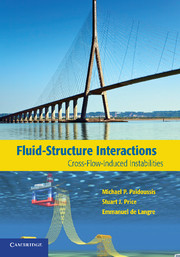Book contents
- Frontmatter
- Contents
- Preface
- 1 Introduction
- 2 Prisms in Cross-Flow – Galloping
- 3 Vortex-Induced Vibrations
- 4 Wake-Induced Instabilities of Pairs and Small Groups of Cylinders
- 5 Fluidelastic Instabilities in Cylinder Arrays
- 6 Ovalling Instabilities of Shells in Cross-Flow
- 7 Rain-and-Wind-Induced Vibrations
- Epilogue
- Appendix A The Multiple Scales Method
- Appendix B Measurement of Modal Damping for the Shells Used in Ovalling Experiments
- References
- Index
2 - Prisms in Cross-Flow – Galloping
Published online by Cambridge University Press: 04 February 2011
- Frontmatter
- Contents
- Preface
- 1 Introduction
- 2 Prisms in Cross-Flow – Galloping
- 3 Vortex-Induced Vibrations
- 4 Wake-Induced Instabilities of Pairs and Small Groups of Cylinders
- 5 Fluidelastic Instabilities in Cylinder Arrays
- 6 Ovalling Instabilities of Shells in Cross-Flow
- 7 Rain-and-Wind-Induced Vibrations
- Epilogue
- Appendix A The Multiple Scales Method
- Appendix B Measurement of Modal Damping for the Shells Used in Ovalling Experiments
- References
- Index
Summary
Introductory Comments
In this chapter, we use the word prism in a general sense to denote a structure of noncircular, not necessarily polygonal, cross-section. We purposely avoid such expressions as “rectangular cylinders”, preferring instead “prisms of rectangular cross-section” or simply “rectangular prisms”.
Consider a slender flexible beam or cable, cross-sectionally bluff, submitted to flow normal to its long axis; or alternatively, a flexibly supported bluff body, as in Figure 1.1. We define galloping as a velocity-dependent, damping-controlled instability, giving rise to transverse or torsional motions – for the present, considering it as a one-degree-of-freedom (1-dof) instability. Parkinson (1971) finds the name “rather appropriate”, “because of the visual impression given” when it occurs in transmission lines: typically a low-frequency (~1 Hz), high-amplitude (as much as 3 m) oscillation, reminiscent of a galloping horse – in contrast, on both counts, to the vortex-shedding related Aeolian vibration. For the same reasons presumably, in the early days, galloping was also referred to as “dancing vibrations”, e.g. by Davison (1930) who was among the first to describe the phenomenon in detail.
A circular cylinder in cross-flow is immune to galloping. As illustrated in Figure 2.1(a), the flow-related force does not change magnitude and is always in the direction of the flow. Hence, when the body is in motion, the cylinder velocity and the component of force in that direction oppose each other, thus negating the possibility of sustenance of the vibration by the flow.
- Type
- Chapter
- Information
- Fluid-Structure InteractionsCross-Flow-Induced Instabilities, pp. 15 - 104Publisher: Cambridge University PressPrint publication year: 2010



